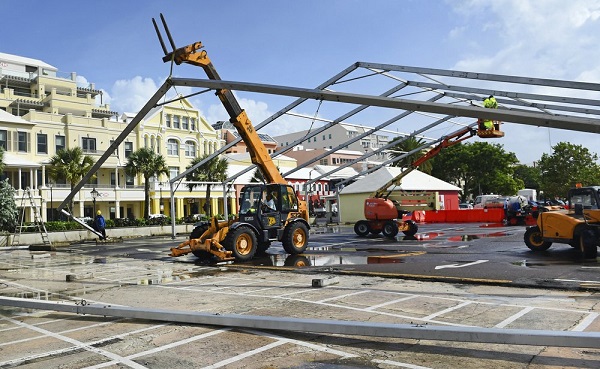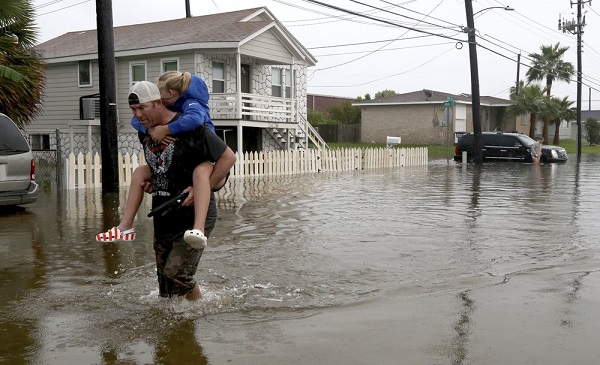Hurricane Humberto blew off rooftops, toppled trees and knocked out power as it blew past the British Atlantic island of Bermuda. But officials said Thursday that the Category 3 storm caused no reported deaths.

Workers take down a tent frame in preparation for Hurricane Humberto in Hamilton, Bermuda, Wednesday, Sept. 18, 2019. (Photos: AP)
"We've made it through and everyone is safe," Premier David Burt said. "That's what is most important."
Security Minister Wayne Caines said schools and government offices would remain closed and he asked people to stay off roads while emergency crews clear them and remove power lines damaged by the hurricane, which had winds of about 120 mph (195 kph) at its nearest approach the Bermuda Wednesday night.
He said Thursday that 28,000 customers on the island of 70,000 people remained without power in the morning.
The U.S. National Hurricane Center said Humberto would still kick up high surf in Bermuda and along the U.S. East Coast.
The storm had maximum sustained winds of at 110 mph (175 kph) late Thursday morning, with tropical storm-force winds extending outward for 405 miles (650 kilometers), covering a huge swath of ocean. The storm was centered about 415 miles (665 kilometers) northeast of Bermuda and moving to the northeast at a brisk 24 mph (39 kph).
Meanwhile, a brush with land near Puerto Vallarta knocked newly formed Hurricane Lorena back down to tropical storm force, though forecasters said it would soon become a hurricane again on a track that would carry it close to the Los Cabos resorts at the tip of the Baja California Peninsula by Friday night or Saturday.

Terry Spencer carries his daughter, Trinity, through high water on 59th Street near Stewart Road in Galveston, Texas, Wednesday, Sept. 18, 2019, as heavy rain from Tropical Depression Imelda caused street flooding on the island.
The storm had maximum sustained winds of 70 mph (110 kph) and it was centered about 15 miles (25 kilometers) west-northwest of Cabo Corrientes, which juts into the Pacific below Puerto Vallarta. It was moving to the northwest at 10 mph (17 kph).
Forecasters said the storm could bring 5 to 10 inches (12.5 to 25 centimeters) of rain to parts of the region and Mexican officials voiced concern that some parts of southern Mexico, which have seen a lack of rainfall, could suffer dangerous flash floods and landslides unleashed by torrential rain.
Schools were closed in parts of the region as a precaution.
Another tropical storm, Mario, was also moving north across the Pacific several hundred miles further out to sea. It was located about 455 miles (730 kilometers) south-southwest of the southern tip of the Baja California Peninsula and had sustained winds of 65 mph (100 kilometers). It wasn't expected to hit land, however.
In Texas and Louisiana, the remains of Tropical Depression Imelda kept bringing rains and flooding. Forecasters warned that Imelda could bring up to 35 inches (90 centimeters) of rain this week in some areas of Texas through Friday.
In the Texas town of Winnie, about 60 miles (95 kilometers) east of Houston, a hospital was evacuated and water was inundating several homes and businesses.
Elsewhere in the Atlantic region, Jerry strengthened into a hurricane on a track that would carry it near the northern Leeward Islands on Friday and north of Puerto Rico on Saturday.
It had maximum sustained winds of 75 mph (120 kph) and was located about 490 miles (785 kilometers) east of the Leeward Islands. It was moving to the west-northwest at 16 mph (26 kph).


